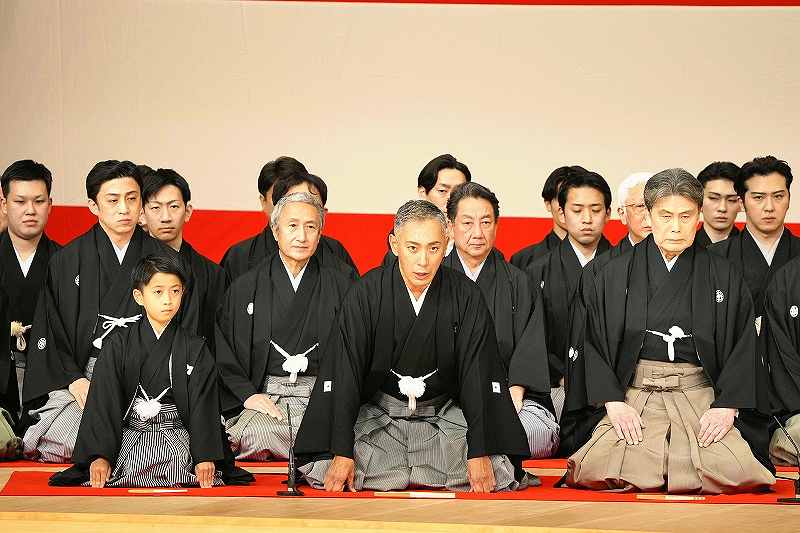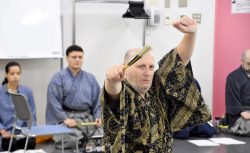
Ichikawa Danjuro XIII, Hakuen plays the role of Musashibo Benkei in the kabuki play “Kanjincho” (“The Subscription Scroll”) at Kabukiza Theatre in Chuo Ward, Tokyo, on Monday.
14:05 JST, November 1, 2022
TOKYO (Jiji Press) — Kabuki actor Ichikawa Ebizo XI assumed the name Ichikawa Danjuro XIII, Hakuen at a special performance in Tokyo on Monday, taking on what is considered the most prestigious stage name in the world of classical Japanese performing arts.
The 44-year-old and kabuki actors who are set to act in performances from November to spread the news of the name succession gathered at the special event at the Kabukiza Theatre in the Ginza district.
“I’m determined to make efforts and work hard day after day so that I can be a Danjuro who will be able to live for kabuki and things about kabuki,” the star actor said in an address as Ichikawa Danjuro Hakuen.
Later in the event, he gave his first performance as the new Danjuro in the role of Musashibo Benkei in “Kanjincho” (“Subscrption Scroll”), one of the Kabuki Juhachiban, 18 plays associated with the Danjuro line of actors. He performed alongside kabuki actors Bando Tamasaburo V and Kataoka Nizaemon XV.
Danjuro took on the name nine years after his father, Ichikawa Danjuro XII, died in 2013. The succession was initially slated for 2020, but was postponed due to the COVID-19 pandemic. The special event is scheduled to be held again today.
The upcoming performances to spread the assumption of the name, which will include “Kanjincho” and “Sukeroku Yukari no Edo Zakura” (“Sukeroku, the Flower of Edo”), will be held at Kabukiza Theatre from Nov. 7 to late December. Danjuro will then tour the country with such name-taking performances through late 2024.
Also on Monday, Danjuro’s son, Kangen Horikoshi, 9, assumed the name Ichikawa Shinnosuke VIII.
Ichikawa Danjuro I (1660-1704), a famed kabuki actor, invented the “aragoto” wild and dynamic style of kabuki performance, and his successors inherited the tradition while seeking to be innovative in their performances.
Danjuro VII, who lived in the latter part of the Edo period (1603-1867), created the Kabuki Juhachiban repertoire, which mainly includes aragoto plays.
Danjuro IX is credited with improving the social status and artistic aspect of kabuki during the Meiji era (1868-1912), while Danjuro XII helped spread Japanese traditional performing arts around the world, holding his name-taking performances in the United States.
The new Danjuro is also open to innovation, such as performing jointly with an opera singer.
“I am on the Danjuro timeline,” he said before assuming the name. “My kabuki will continue to be classic yet heretical.”

Ichikawa Danjuro XIII, Hakuen greets the audience during the hand-clapping ceremony for stage name successions at Kabukiza Theatre in Tokyo on Monday. Flanking him are his son Ichikawa Shinnosuke VIII and kabuki actor Matsumoto Hakuo II.
"Culture" POPULAR ARTICLE
-

Van Cleef & Arpels Dazzles with Art Deco Artisanry at Tokyo Exhibit
-

Disney’s ‘Twisted-Wonderland’ Animated Series Puts Villains in Spotlight: New Show Features School Inspired by Classic Disney Films
-

Japan Plans to Distribute Manga Overseas Via New Platform
-

Japanese Craftsman Produces Beautiful and Durable Bags Made of Wood
-

Ayumi Hamasaki’s Shanghai Concert Canceled Day Before Schedule as Part of Beijing Backlash
JN ACCESS RANKING
-

Keidanren Chairman Yoshinobu Tsutsui Visits Kashiwazaki-Kariwa Nuclear Power Plant; Inspects New Emergency Safety System
-

Imports of Rare Earths from China Facing Delays, May Be Caused by Deterioration of Japan-China Relations
-

University of Tokyo Professor Discusses Japanese Economic Security in Interview Ahead of Forum
-

Japan Pulls out of Vietnam Nuclear Project, Complicating Hanoi’s Power Plans
-

Govt Aims to Expand NISA Program Lineup, Abolish Age Restriction

























